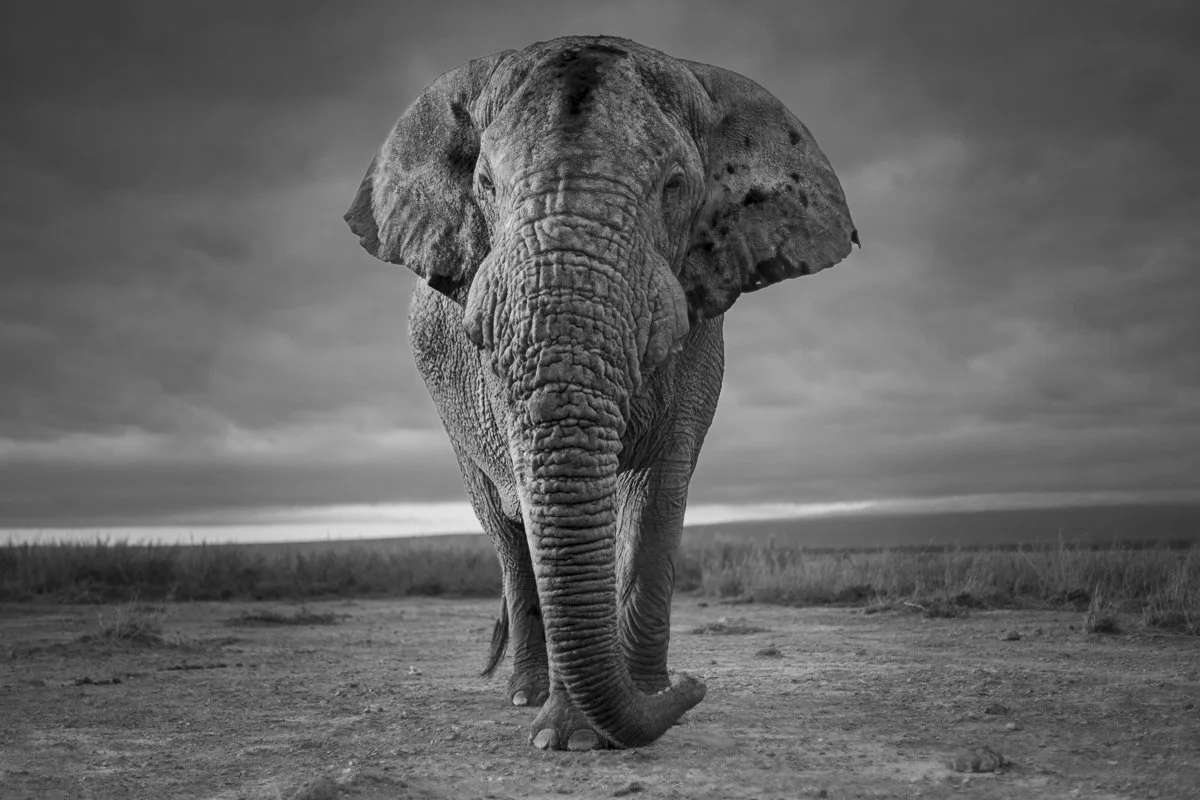AMBOSELI ELEPHANTS: A STORY OF RESLIENCE
Amboseli Elephants
I first visited Amboseli in 2021 and it has had a profound effect not only on my appreciation of elephants but also on my photography. Whether it’s seeing large herds of elephants roaming freely over the savannah, intimate moments between a mother & calf or the sheer size of the big Tuskers, there is nowhere quite like it for photographing elephants. That’s why it has now become one of my “go to” yearly destinations.
I’ve been very lucky over the past 3 years to have had encounters with Craig, the world’s oldest and biggest Tusker, and Vronsky who I always enjoy seeing. However, one elephant that has a special place in my heart is one who you may never have heard of but who has one of the most amazing stories to tell- Equinox.
This is a portrait of Equinox, a tuskless bull elephant which I took in 2022. I was with my guide David and we not only noticed this huge bull elephant moving towards our vehicle but could also smell him as he was in musth. When an elephant is in musth you have to be a little wary as they can become aggressive but, in this instance, Equinox just went on his way without any drama.
Whilst I was really pleased with this image, as I loved the mood & texture, at first there was also a bit of disappointment as I thought the lack of tusks on the elephant meant it lacked impact. However, I was intrigued as to what had happened. I asked David but he didn’t know, so I contacted the Amboseli Trust for Elephants, an amazing Elephant charity which has been following all the elephants in the park for over 50 years. What they told me was truly fascinating.
The story of Equinox, a rare twin Elephant
Equinox was born a twin in 1980 and remarkably both he and his sister Eclipse survived to adulthood. To be born a twin is extremely rare, but for both elephants to survive to adulthood is rarer still. Then a few months before my encounter with him, he broke both his tusks which could have been because of a fight or because of falling on rocks. Either way, as they were broken so high the nerve would have been exposed so this would have been extremely painful. Equinox had to recover & learn how to feed without his tusks. On top of this he, as well as all the elephants in the Amboseli eco systemin June 2022 were having to deal with one of the worst droughts in recent memory.
So, whilst he was an elephant that has survived the odds more than once and has shown extraordinary resilience, I did wonder whether he would survive the drought.
Portraits of Equinox, one of the most resilient elephants in Amboseli
A new sighting of Equinox
I returned to Amboseli early the following year and there was no sign of Equinox, but on my return in January 2024, I was looking through my binoculars at a group of bull elephants and I recognised him by his distinctive head and trunk & of course the lack of tusks. I was so thrilled at seeing him again.
He’d survived the most serious drought in Amboseli for over a decade, he was feeding with other bull elephants and what was truly remarkable his tusks, which are essentially incisor teeth, were continuing to grow and you could clearly see them now.
Equinox was named after the balance of day and night. He’s a living testament to the power of resilience and the extraordinary stories of nature that often go unnoticed. I think he’s remarkable and really hope I get to see him again on my next visit to Amboseli later in February.
If you want to find out more about Equinox or other Amboseli Elephants check out the work of the following organizations who do incredible work to protect & preserve the long-term conservation of Elephants in Amboseli & across the whole of Africa
Thanks again to Eric, An, David and the whole team at Elephant Garden Camp.
My home from home in Amboseli.
If you want to read more about the Tusker Elephants in Amboseli, including Craig, Vronsky and others check out my blog “Tusker Elephant Photography: Iconic African Giants of Amboseli” where I share some of my personal stories of interactions with these gentle giants. And for more award winning Elephant photography check out my Elephants of Africa collection.
I really appreciate you taking the time to read this blog and checking out other content on my website. If you are interested in knowing more let me know your questions via this link or connect with me on Instagram — I love hearing from fellow elephant lovers!
Thank you!
Jules









